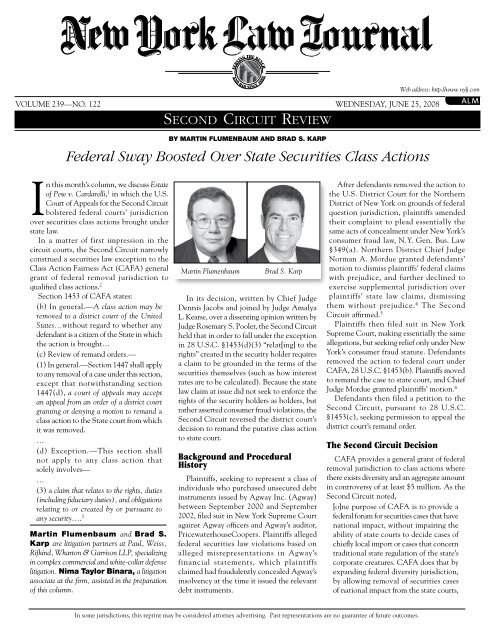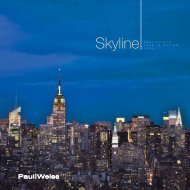Full PDF - Paul, Weiss, Rifkind, Wharton & Garrison
Full PDF - Paul, Weiss, Rifkind, Wharton & Garrison
Full PDF - Paul, Weiss, Rifkind, Wharton & Garrison
- No tags were found...
Create successful ePaper yourself
Turn your PDF publications into a flip-book with our unique Google optimized e-Paper software.
SERVING THE BENCHAND BAR SINCE 1888Volume 239—no. 122 wednesday, june 25, 2008Second Circuit ReviewBy Martin Flumenbaum and Brad S. KarpFederal Sway Boosted Over State Securities Class ActionsWeb address: http://www.nylj.comIn this month’s column, we discuss Estateof Pew v. Cardarelli, 1 in which the U.S.Court of Appeals for the Second Circuitbolstered federal courts’ jurisdictionover securities class actions brought understate law.In a matter of first impression in thecircuit courts, the Second Circuit narrowlyconstrued a securities law exception to theClass Action Fairness Act (CAFA) generalgrant of federal removal jurisdiction toqualified class actions. 2Section 1453 of CAFA states:(b) In general.—A class action may beremoved to a district court of the UnitedStates…without regard to whether anydefendant is a citizen of the State in whichthe action is brought…(c) Review of remand orders.—(1) In general.—Section 1447 shall applyto any removal of a case under this section,except that notwithstanding section1447(d), a court of appeals may acceptan appeal from an order of a district courtgranting or denying a motion to remand aclass action to the State court from whichit was removed.…(d) Exception.—This section shallnot apply to any class action thatsolely involves—…(3) a claim that relates to the rights, duties(including fiduciary duties), and obligationsrelating to or created by or pursuant toany security…. 3Martin Flumenbaum and Brad S.Karp are litigation partners at <strong>Paul</strong>, <strong>Weiss</strong>,<strong>Rifkind</strong>, <strong>Wharton</strong> & <strong>Garrison</strong> LLP, specializingin complex commercial and white-collar defenselitigation. Nima Taylor Binara, a litigationassociate at the firm, assisted in the preparationof this column.Martin FlumenbaumBrad S. KarpIn its decision, written by Chief JudgeDennis Jacobs and joined by Judge AmalyaL. Kearse, over a dissenting opinion written byJudge Rosemary S. Pooler, the Second Circuitheld that in order to fall under the exceptionin 28 U.S.C. §1453(d)(3) “relat[ing] to therights” created in the security holder requiresa claim to be grounded in the terms of thesecurities themselves (such as how interestrates are to be calculated). Because the statelaw claim at issue did not seek to enforce therights of the security holders as holders, butrather asserted consumer fraud violations, theSecond Circuit reversed the district court’sdecision to remand the putative class actionto state court.Background and ProceduralHistoryPlaintiffs, seeking to represent a class ofindividuals who purchased unsecured debtinstruments issued by Agway Inc. (Agway)between September 2000 and September2002, filed suit in New York Supreme Courtagainst Agway officers and Agway’s auditor,PricewaterhouseCoopers. Plaintiffs allegedfederal securities law violations based onalleged misrepresentations in Agway’sfinancial statements, which plaintiffsclaimed had fraudulently concealed Agway’sinsolvency at the time it issued the relevantdebt instruments.After defendants removed the action tothe U.S. District Court for the NorthernDistrict of New York on grounds of federalquestion jurisdiction, plaintiffs amendedtheir complaint to plead essentially thesame acts of concealment under New York’sconsumer fraud law, N.Y. Gen. Bus. Law§349(a). Northern District Chief JudgeNorman A. Mordue granted defendants’motion to dismiss plaintiffs’ federal claimswith prejudice, and further declined toexercise supplemental jurisdiction overplaintiffs’ state law claims, dismissingthem without prejudice. 4 The SecondCircuit affirmed. 5Plaintiffs then filed suit in New YorkSupreme Court, making essentially the sameallegations, but seeking relief only under NewYork’s consumer fraud statute. Defendantsremoved the action to federal court underCAFA, 28 U.S.C. §1453(b). Plaintiffs movedto remand the case to state court, and ChiefJudge Mordue granted plaintiffs’ motion. 6Defendants then filed a petition to theSecond Circuit, pursuant to 28 U.S.C.§1453(c), seeking permission to appeal thedistrict court’s remand order.The Second Circuit DecisionCAFA provides a general grant of federalremoval jurisdiction to class actions wherethere exists diversity and an aggregate amountin controversy of at least $5 million. As theSecond Circuit noted,[o]ne purpose of CAFA is to provide afederal forum for securities cases that havenational impact, without impairing theability of state courts to decide cases ofchiefly local import or cases that concerntraditional state regulation of the state’scorporate creatures. CAFA does that byexpanding federal diversity jurisdiction,by allowing removal of securities casesof national impact from the state courts,In some jurisdictions, this reprint may be considered attorney advertising. Past representations are no guarantee of future outcomes.
New York Law Journal wednesday, june 25, 2008and by conferring appellate jurisdiction toreview orders granting or denying motionsto remand such removed cases. 7The court also observed, however, thatthere is “an exception to CAFA’s grant oforiginal [and appellate] federal jurisdiction, forany class action that solely involves a claim…that relates to the rights, duties (includingfiduciary duties), and obligations relating to orcreated by or pursuant to any security.” 8 Thekey question faced by the court, then, waswhether a state law class action—involvinga sale of securities but based on consumerfraud laws—was removable to federal courtunder CAFA, or whether the district courtproperly remanded the case to state court underCAFA’s exception for cases “relat[ing] to therights, duties…, and obligations relating to…any security.”As an initial matter, the Second Circuitjoined the Third, Ninth, Tenth and Eleventhcircuits in holding that §1453(c)(1)’srequirement that a petition to review aremand order be filed “not less than 7 days afterentry of the order” contained a typographicalerror. The court ruled that the “uncontestedlegislative intent behind” the statute wasnot to impose a waiting period, but rathera deadline of “not more than 7 days.” 9 Thecourt found that defendants had made a timelypetition to review the district court’s decisionto remand, and so review was proper.Turning to the district court’s decision toremand the case based on CAFA’s exceptionfor claims relating to the rights, duties, andobligations relating to any security, the SecondCircuit held that the plain meaning of thestatute was “ambiguous” because of “imperfectdrafting.” 10 As a result, the court examinedthe statute’s wording, statutory context andlegislative history.With respect to the wording of§1453(d)(3), the court divided the clause intofour subclauses:[i] the section “shall not applyto any class action that solelyinvolves a claim…that relates to[ii] the rights, duties…, and obligations[iii] relating to or created by orpursuant to[iv] any security….” 11The court held that the clause cannot beread to cover any and all securities, becausethat would afford no meaning to subclauses[ii] and [iii], which it concluded are termsof limitation. The court held that “duties”are owed by persons (human or artificial);“obligations” are owed by instruments; and“rights” are those of the security holdersto whom these duties and obligations run.Although the court acknowledged that theAgway debt instruments created “obligations”and therefore corresponding “rights,” plaintiffs’lawsuit did not implicate those rights becausethe lawsuit was based on state-law consumerfraud claims, rather than “claims grounded inthe terms of the security itself.” 12 As a result,the court ruled that the lawsuit does not“relate[] to” those rights and obligations, soit does not fall under the exception to CAFA’sremoval provision.The court then examined the statutorycontext and legislative history of CAFA. Itheld that the statute “confirms an overalldesign to assure that the federal courts areavailable for all securities cases that havenational impact…, without impairing theability of state courts to decide cases of chieflylocal import or that concern traditional stateregulation of the state’s corporate creatures.” 13The statute’s legislative history, as well,confirms this reading, according to the court.Congress “intended that [the exception at issuein §1453(d)(3)] should be reserved for disputesover the meaning of the terms of a security,such as how interest rates are to be calculated,and so on.” 14 The court concluded that thewording, statutory context and legislativehistory of CAFA are consistent.xxxxxxxxxxxxxxThe Second Circuit ruledthat to fit within theexception allowing remandto state court a lawsuit mustconcern the rights, duties orobligations that are groundedin the terms of thesecurities themselves.xxxxxxxxxxxxxxConclusionThe Second Circuit, therefore, ruled that astate-law securities class action that otherwisesatisfies the relatively low jurisdictionalthreshold for federal removal under CAFAwill not be remanded to state court solelybecause the lawsuit relates in some way toany securities. Instead, the court ruled that tofit within the exception allowing remand tostate court a lawsuit must concern the rights,duties or obligations that are grounded in theterms of the securities themselves. Becausethe putative class action in question was notgrounded in the actual terms of the securitiesat issue, the Second Circuit (i) ruled that ithas appellate jurisdiction to review the districtcourt’s remand order, (ii) granted defendantsleave to appeal, (iii) reversed the districtcourt’s order to remand the case to state court,and (iv) remanded the case to the districtcourt for further proceedings consistent withits opinion.••••••••••••• • •• •••••••••••••1. Estate of Pew v. Cardarelli, No. 06-5703, 2008 WL2042809 (2d Cir. May 13, 2008) (Estate of Pew).2. Class Action Fairness Act of 2005, Pub.L. No. 109-2, 119 Stat. 4 (codified at 28 U.S.C. §§1332(d), 1453, and1711-15).3. 28 U.S.C. §1453 (emphasis added). 28 U.S.C.§1332(d) confers original federal jurisdiction over any classaction with minimal diversity and an amount in controversyof at least $5 million. However, §1332(d)(9)(C) providesan exception for class actions relating to the rights, duties,and obligations relating to any security, using language thatparallels the exception to the removal provision containedin §1453(d)(3). Thus, as the Second Circuit noted, “CAFA’sjurisdictional and removal provisions operate in tandem.”Estate of Pew, 2008 WL 2042809 at * 5.4. See Pew v. Cardarelli, No. 5:03-cv-742, 2005 WL3817472 *7 (N.D.N.Y. March 17, 2005); Id. at *16.5. See Pew v. Cardarelli, 164 Fed.Appx. 41, 44 (2d Cir.2006) (summary order).6. See Estate of Pew v. Cardarelli, No. 5:05-cv-1317, 2006WL 3524488 (N.D.N.Y. Dec. 6, 2006).7. Estate of Pew, 2008 WL 2042809 at * 1 (internalquotations omitted).8. Id. at *4. CAFA also contains exceptions, not relevanthere, relating to a “covered security” under the Securities Actof 1933 and relating to “the internal affairs or governanceof a corporation or other form of business enterprise andaris[ing] under or by virtue of the laws of the State in whichsuch corporation or business enterprise is incorporated ororganized.” 28 U.S.C. §1453(d)(1)-(2).9. Estate of Pew, 2008 WL 2042809 at *2 (emphasis inoriginal) (discussing Morgan v. Gay, 466 F.3d 276 (3d Cir.2006); Miedema v. Maytag Corp., 450 F.3d 1322 (11th Cir.2006); Amalg. Transit Union Local 1309 v. Laidlaw TransitServs. Inc., 435 F.3d 1140 (9th Cir. 2006); Pritchett v. OfficeDepot Inc., 420 F.3d 1090 (10th Cir. 2005)).10. Id. at *4. The dissent criticized the majority’sconclusion that the statute was ambiguous. See id. at *8.11. Id. at *5. As noted, §1332(d)(9)(C) contains parallellanguage relating to federal jurisdiction.12. Estate of Pew, 2008 WL 2042809 at * 6.13. Id.14. Id. at *7 (quotations omitted).Reprinted with permission from the June 25, 2008 edition ofthe New York Law Journal © 2008 ALM Properties, Inc. Allrights reserved. Further duplication without permission isprohibited. For information, contact 212-545-6111 or cms@alm.com. # 070-06-08-0039
















